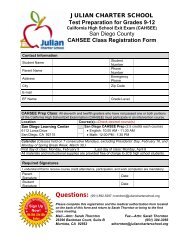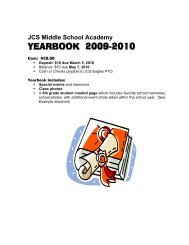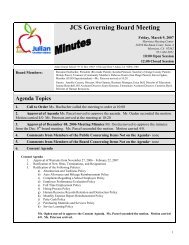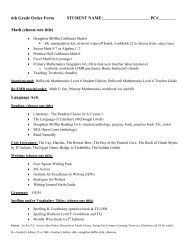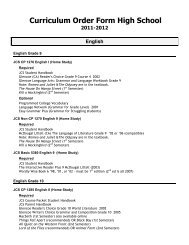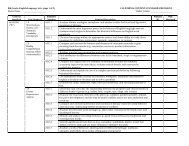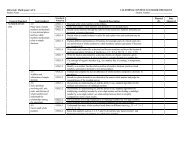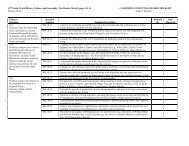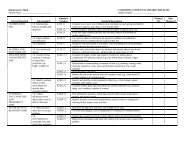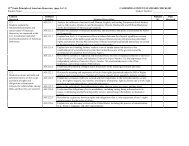2009-2010 Self-Study WASC Action Plan - Julian Charter School
2009-2010 Self-Study WASC Action Plan - Julian Charter School
2009-2010 Self-Study WASC Action Plan - Julian Charter School
You also want an ePaper? Increase the reach of your titles
YUMPU automatically turns print PDFs into web optimized ePapers that Google loves.
• ESLRs are designed to promote the integration of skills<br />
such as critical thinking, problem solving and communication<br />
in the teaching of core academic subjects.<br />
• PLCs are beginning to work on designing curriculum<br />
that explicitly integrates 21st century skills<br />
within the context of core academic subjects.<br />
• Model units include the integration of 21st century<br />
skills in a meaningful, real-world context.<br />
• Curriculum design processes follow backwards-design<br />
principles (e.g., Understanding by Design); teams are<br />
in the process of identifying 21st century skills as key<br />
outcomes.<br />
• Curriculum-embedded assessments are common<br />
practice and may include authentic tasks.<br />
• Curriculum design within a personalized learning program<br />
provides opportunities to:<br />
• Learn about subjects of interest in depth<br />
• Connect new learning across disciplines<br />
• Connect new learning to prior knowledge<br />
• Construct new knowledge<br />
• Apply learning in real-world contexts<br />
• Curriculum design in a personalized learning program<br />
includes a variety of approaches to and philosophies<br />
of learning. Academies and the high school program<br />
more frequently differentiate curriculum using<br />
strategies from the first column below, while home<br />
study students may come to us with a style of education<br />
already decided (based on the second column)<br />
and then incorporate strategies from the first column.<br />
• For example, a home study family using a Classical<br />
approach studies a medieval scholastic curriculum<br />
where all subjects are taught concurrently. All of<br />
the children in the family study the same topic(s)<br />
at the same time with varying levels of curricular<br />
support materials and instruction.<br />
• ESLRs<br />
• Curriculum maps<br />
• PLC, forum, site, department<br />
and curriculum team<br />
meeting notes<br />
• Student interviews<br />
• Student work<br />
• Professional development<br />
logs and book lists<br />
• Benchmark tests, Friday<br />
Quick Checks, DataDirector<br />
assessment database<br />
• ReportWriter assignments<br />
• JCS Online and courses of<br />
study, pacing guides, scope<br />
and sequence charts (textbooks,<br />
CLO, mapping)<br />
• Concern reports/IEP goals<br />
• K-8 academy Individual<br />
Learning <strong>Plan</strong>s (ILPs)<br />
• Teacher and parent<br />
interviews<br />
• Handouts from parent<br />
professional development<br />
sessions<br />
Resource Center:<br />
• Houses over 990,000<br />
pieces of curriculum and<br />
learning tools<br />
• Includes professional<br />
development resources<br />
for both parents and<br />
teachers<br />
• Learning Styles<br />
• Project/Problembased<br />
Learning<br />
• Constructivism<br />
• Brain-based<br />
• Metacognition<br />
• Experiential<br />
• Charlotte Mason<br />
• Classical<br />
• Eclectic<br />
• Traditional<br />
• Unit Studies<br />
• Unschooling<br />
• Waldorf<br />
Ongoing and Future<br />
Professional Development:<br />
• Curricular design<br />
• Curricular approaches<br />
• Curriculum differentiation<br />
• Backwards-design<br />
• Curriculum mapping<br />
Chapter 4: <strong>Self</strong>-<strong>Study</strong> Findings: Curriculum<br />
60 <strong>Julian</strong> <strong>Charter</strong> <strong>School</strong> Focus on Learning <strong>2009</strong>-<strong>2010</strong>



